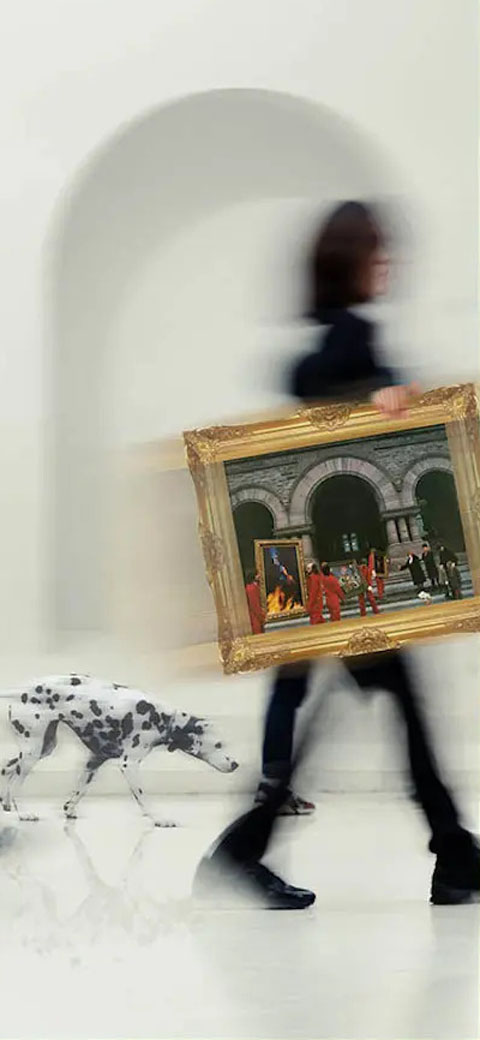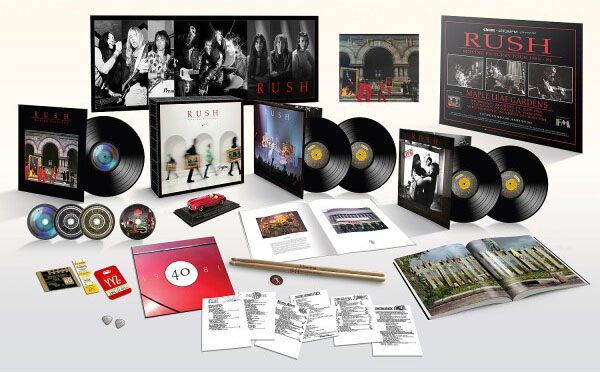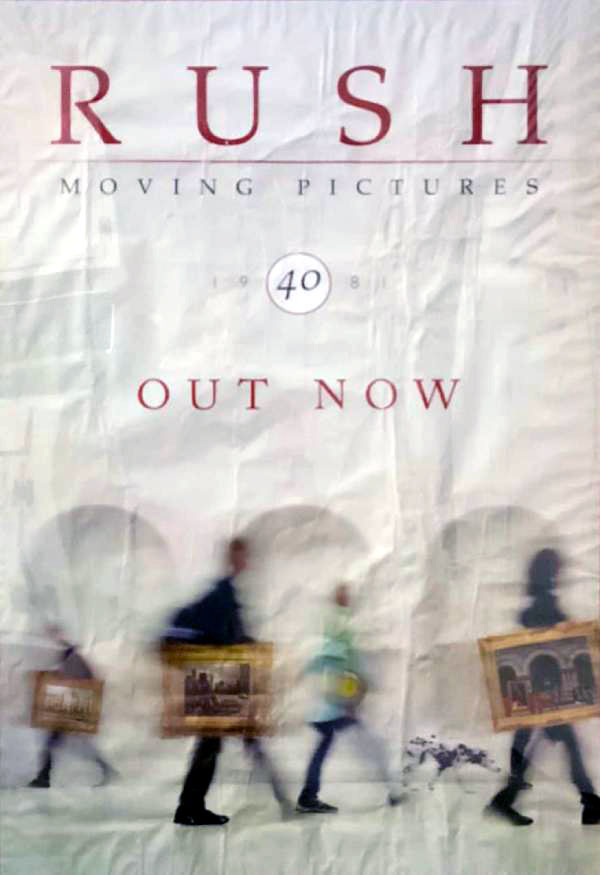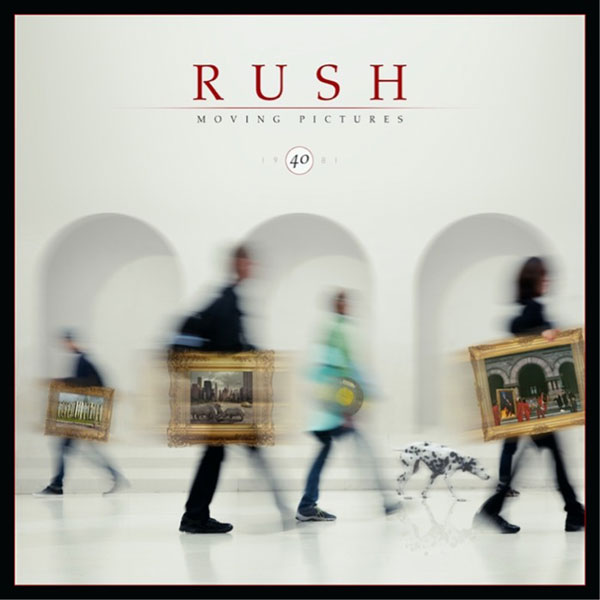
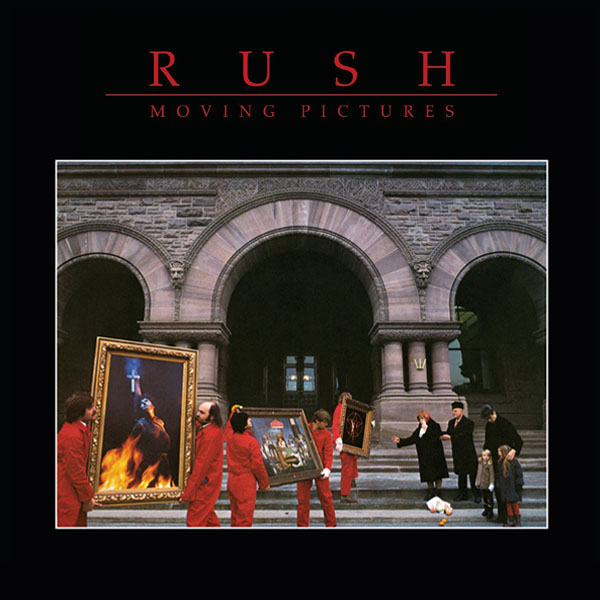
Original Album (2015 remaster)
CD One
Tom Sawyer (4:33)
Red Barchetta (6:06)
YYZ (4:24)
Limelight (4:19)
The Camera Eye (10:56)
Witch Hunt (Part III of Fear) (4:43)
Vital Signs (4:43)
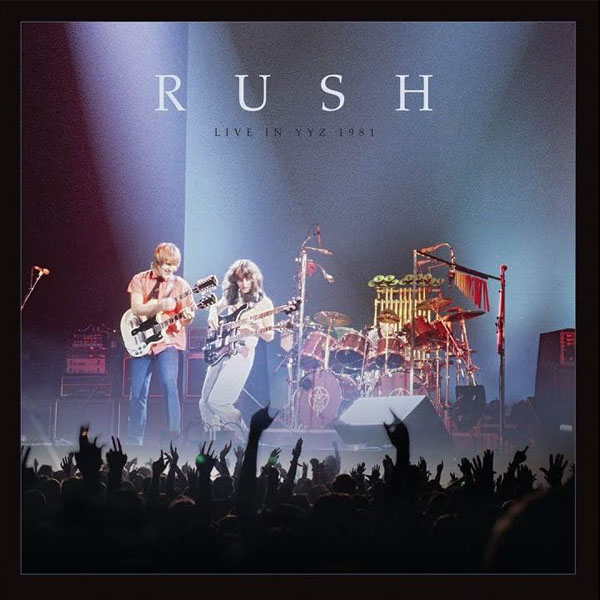
Live In YYZ 1981
CD Two
2112 - Overture
2112 - The Temples Of Syrinx
Freewill
Limelight
Hemispheres - Prelude
Beneath, Between & Behind
The Camera Eye
YYZ
Broon's Bane
The Trees
Xanadu
CD Three
The Spirit Of Radio
Red Barchetta
Closer To The Heart
Tom Sawyer
Vital Signs
Natural Science
Working Man /
Hemispheres – Armageddon: The Battle Of Heart And Mind /
By-Tor & The Snow Dog /
In The End /
In The Mood /
2112 – Grand Finale
La Villa Strangiato
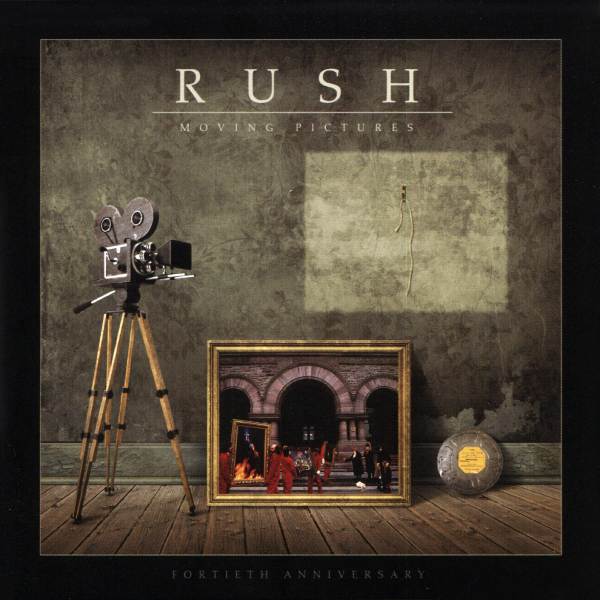
Blu-Ray (Super Deluxe Edition Exclusive)
- Audio Options
- Dolby Atmos
- Dolby TrueHD 5.1
- DTS-HD Master Audio 5.1
- PCM Stereo
- Bonus Videos
- Tom Sawyer
- Limelight
- Vital Signs
- YYZ previously unreleased
Moving Pictures 40th Anniversary Linernotes
I promise I am not going to claim that it's hard to believe it's been forty years since Rush's Moving Pictures was released. It's very believable; Moving Pictures was of its time. What's hard to believe is that over those forty years the album would continue to grow on me, sustain my interest and that of many of my friends and fellow musicians, until its greatness as an influential and classic album was eventually understood by me. It's not likely possible that its status as one of the greatest rock albums of all-time could have been known in 1981, or in the few years that followed. How could anyone anticipate the cultural contexts that would frame the merits of the album, or that were influenced and formed by the record over four decades!
Oh, it was amazing in its day! It sold millions of copies; it was all over the radio dial, both FM AOR and AM top 40. It was ubiquitous: at parties. teenage car stereos, shopping mall record stores, bar jukeboxes and even a few convenience stores. Also, the album's instrumental track, "YYZ" was nominated for a Grammy® Award for Best Rock Instrumental Performance. Aside from "The Camera Eye" and "Red Barchetta," the record's other 5 tracks had radio friendly lengths of about 4-1/2 minutes. This, I'm sure, facilitated the album's airplay. Rush had been known for the multi-movement, lengthy epic, although they had written many compact hard rockers. The entire album was around 40 minutes long indicating its playing time was oriented towards the vinyl LP format, the dominant format of the day. The 8-track tape cartridge was a format on its way out after the 1970s, but convenient for car stereos. The compact audio cassette was simultaneously growing in popularity and was supplanting the 8-track cartridge in album sales. Moving Pictures was released on both of these formats, which probably did a disservice to Hugh Symes's witty album cover that contained a visual poly-entendre for the album's title. There weren't any CDs or streaming services available in 1981. In spite of this period of record sales pre-dating the digital revolution, the album was still recorded with the state-of-the-art equipment and techniques of its day, which satisfied the audiophiles. Terry Brown's production methods always seemed to parallel the band's growth and meet their needs as experimenters and innovators.
Moving Pictures had plenty of competition for those accolades and radio real estate during the year preceding thru the year after its release. 1980 - '82 saw hard rock/metal releases by Judas Priest, Scorpions, Motorhead, Black Sabbath, Rainbow, Blue Oyster Cult and KISS to name a few. There were many HUGE selling albums from The Rolling Stones, Foreigner, The Police, Van Halen, Queen and of course, AC/DC. Plus. there were debuts from Def Leopard, Iron Maiden, Motley Crue, Ozzy Osbourne and U2! Rush themselves also released Permanent Waves and Signals during this period around Moving Pictures.
With such a broad and dense amount of harder rock bands releasing albums and touring during that period, how did Rush distinguish themselves from the field? I'm sure there were many factors in play, but by addressing the fan base they had built during the previous decade, a loyal base that had come to expect innovation and experimentation from the band, they could expand their sound by incorporating other genres that had been gaining popularity in recent years.
Along with their increasing interest in progressive rock during and since the '70s, they also dabbled in elements of that decade's jazz/rock fusion. "YYZ" displays these two genres brilliantly! The influence of the bands King Crimson and UK are very apparent to me, but the surprise is not in the prog elements shown here. Neil Peart had long established his talent and propensity for the style which helped define Rush's sound (It's also super badass that the band riffed out the rhythm of "'YYZ'," the Toronto airport IATA identifier, in Morse code!). The surprise is Alex Lifeson's demonstration of his jazz fusion acumen with solos and leads that remind me of Steve Morse from Dixie Dregs with a bold hint of Jeff Beck.
There were other styles that were influencing rock music at that time, which Rush began incorporating into their songwriting. These included reggae and synthesizer pop, which were both genres that gained popularity within the context of rock's new wave. In the late '70s, the punk/new wave movement produced rock bands that incorporated reggae and its cousins, ska, two tone and dub into their sound. One of the most successful of these bands was another power trio of that time, The Police. Rush first introduced these rhythms on their previous album, Permanent Waves, with "The Spirit of Radio" and revisited the style on "Vital Signs."
Synthesizers hadn't been commonly used with pop, hard rock, or heavy metal bands during the early-thru-mid '70s. They were usually heard on prog rock albums by bands such as King Crimson, Yes, or Pink Floyd. A few art rock bands, such as Roxy Music and David Bowie, regularly recorded with synthesizers at that time. During this decade. Rush used synthesizers sparingly within this context, to augment the prog elements in their music. During the new wave, a bolder use of synthesizers began appearing in rock and pop songs. Bands like Devo, Ultravox and Gary Numan's Tubeway Army incorporated electronics into their guitar dominant rock. By the early '80s, the guitar had become subordinate to the keyboard electronics of the new romantic movement. Synth pop had arrived with bands such as Eurythmics, Soft Cell, Culture Club and A Flock of Seagulls. With Rush's new, more radio friendly song lengths, their synthesizers found a place outside of the prog rock & special effects utility and became a more featured instrument within their hard rock sounds and pop song structures.
Ultimately, the fact that Rush was a band that was willing to take risks, grow and challenge themselves, allowed them to succeed during this period of rapid transformation and expansion for rock and pop music. They seemed to be able to compete for the very limited entertainment dollar of the young rock fan while growing their audience. Moving Pictures appeared to be very much of its time. However, during these same years, there were other genres that would prove to be huge and transformative of the music industry... other new music styles that a band like Rush might find their sound out of step with... that might have been difficult for them to explore and incorporate. These genres would include disco, rap & hip hop, and punk rock.
The former which appeared to have been a commercial fad that rock music ultimately survived and then dominated, merely transformed and rebranded itself. Although disco's culture and popularity was over by 1981, its techniques and music branched into a number of very successful sub-genres of DJ led music such as electronic dance music and techno.
The latter two genres would shake up the music industry by rising, unexpectedly out of underground indie movements. These music scenes would grow throughout the '80s and come to dominate the music industry: Rap by the late '80s, punk and its variances by the early '90s.
Moving Pictures and Rush also had great competition from outside of the established genres from which they were formed and would influence, and from the newer genres which they would adopt. This competition wasn't for accolades, or radio air time. It was for the hearts, minds and ears of a younger generation along with a segment of their fan base that was entering into adulthood. Even with all of the hard rock/metal releases and debuts of the period, 1980 - '82 also saw punk rock and post-punk releases from The Clash, The Ramones, Joy Division, Bauhaus, The Cure, The Damned, Gang of Four and X. Punk rock also offered up debuts from Black Flag, Dead Kennedys, Misfits, The Replacements, D.O.A., The Cramps and Bad Brains (who also incorporated reggae into their hardcore punk). Rap/hip hop saw debuts from Afrika Bambaataa and Grand Master Flash and the Furious Five. These records may not have been big sellers (except The Clash's Combat Rock), but they were incredibly influential to a new generation of musicians and fans. So, although Moving Pictures was a hugely successful milestone album for Rush, it's perhaps arguable that the album was culturally after its time.
I was twenty years old when Moving Pictures came out in 1981, and I immediately took to the songs "Tom Sawyer" and "Limelight" which I would hear regularly on FM album-oriented rock (AOR) radio in Chicago, where I was raised. I had a car at that time. No, unfortunately, it was not a red barchetta, it was a gray '72 Toyota Corolla. I seem to recall also hearing "Tom Sawyer" on my car's AM radio. The album was very successful and received quite a bit of airplay in the Chicago metropolitan area. Rush had been a favorite band amongst my friends, many of which were musicians. Most of them very bright and free thinking. They weren't the cool kids, nor were they hipsters. They were smart... band geek, radio station and newspaper staff types. As teenagers we had established bonds of friendship that formed a culture that consisted of books, record albums, movies, and recreational intoxicants, mostly beer and pot. We would play music together, if a garage or basement was available. Rush figured significantly within our group of friends. We already understood Rush to have had a classic career defining and iconic album, this was 2112.
2112 came out when I was fifteen years old. I probably heard it from friends when I was sixteen. This was when friendships were being formed that would last throughout high school and a few that would last into young adulthood and to this day. This was also when I began learning how to play guitar and jam with other kids that played. Rush figured prominently with our socialization. My friends would clean their pot on the gatefold cover of2112 in preparation for a bong-a-thon competition where we'd pass around a bong with a large bowl until everyone dropped out - but one, the bong-a-thon champion. The soundtrack for these competitions were usually the record inside of the gatefold jacket. Pink Floyd's Dark Side of the Moon was commonly played, perhaps a Zappe album or two, and especially Rush's 2112. We'd mimic the line, "Attention all planets of the solar federation. We have assumed control!" and argue about how Geddy Lee could sing so high, or ask, if there was a rock drummer that could possibly be better than Neil Peart? Often someone would believe they had figured out some band's song, or at least part of a cool riff. Debates would then ensue between guitarists, drummers, bass and horn players over whether a riff was being performed correctly. There was no Internet to reference in order to settle these arguments. We would simply play and replay a track over and over on a record to demonstrate how a passage or riff was supposed to be played. When not challenging each other's developing musical aptitude we'd simply talk about girls we were interested in, or cars that we'd like to buy some day. We'd discuss current events and books we had read. Ayn Rand came up frequently, since we were precocious, curious and her writings had been endorsed by Rush in the liners for 2112. Our entire youth culture could've been defined by parallels with the 1970s rise of AOR radio. classic rock (heavy metal, prog, Jazz fusion and hard rock music), stoner culture, muscle cars, electric instruments, component stereos and blue jeans. Rush was integral to our bonding and the development of our social identities.
As we grew up, so did classic rock and so did Rush. Concert tours began to fill baseball and football stadiums during the mid-to-late '70s. Many bands expanded their sounds with slicker production that utilized the newest recording technologies. Their writing and arranging would incorporate a variety of instrumentation and styles that were new for the groups. Classic rock had become stadium rock. In a few cases it became classical rock by incorporating orchestral arrangements. New musical genres such as disco, rap & hip hop, punk and new wave were gaining popularity, The decade was progressing; music groups were growing and changing. Rush was changing, becoming more prog and increasing their use of synthesizers. Those of us born in the early 1960s, were becoming young adults and our lives were also changing.
The late '70s found those born at the tail-end of the Baby Boom exiting high school and then their teens. Our lives were changing. We entered into romantic relationships, got jobs, purchased cars. We went off to college, joined the military, left home and moved on. We had new lives, expenses and interests. This included taste in music. Classic rock was still important, but now we were listening to new recording artists with new song and performance styles. Many friends started exploring punk and new wave bands. Some friends were getting into jazz: fusion, free, cool, modal. A few female friends were into disco and early hip hop. There were, surprisingly, a handful of classic rock and new wave groups that recorded disco songs! Rush didn't really explore punk, hip hop, or disco. Because many in our age range were exploring these new genres, it seemed that perhaps Rush's relevance to us had passed. We still liked them, but new music and new responsibilities gained our attention.
By 1981 I had played in a couple of bands. We wrote punk rock and power pop songs. Frankly, it was much easier for me and my bandmates to play Ramones songs than it would have been to play Rush songs! We weren't that experienced on our instruments then. However, interpretations of the opening guitar lick from "The Spirit of Radio" did make its way around guitarists' circles. I admit to obsessively working on it alone in my bedroom! Although I played and listened to punk and related styles of hard-edged music, classic rock was everywhere in the mainstream of popular music. The songs from Moving Pictures were all over the radio and elsewhere. "Tom Sawyer" evoked a sense of wonder that was reminiscent of the stories of Ray Bradbury in spite of the obvious references to Mark Twain and Ayn Rand. "Red Barchetta," my favorite song from the album, and "Limelight" also evoked that sense of wonder for me. It was as though the sky was opened; the horizon was acknowledged and a sublime awareness was ushered in. Perhaps my experience with these songs reflected where my life was at the time. It held a world of possibilities. I was to turn twenty-one years old and I had decided to move out and move on. By October of 1981, I was driving on my way to Seattle, Washington with my friend Hiro Yamamoto. I was to leave Chicago, and my youth behind. This would include much of that which gave my youth cultural reference and context. Three years later. Hiro and I would form Soundgarden.
My experiences with independence, as a young adult in Seattle, involved learning about many developing ideas and styles in art, literature, music and politics. As a philosophy student at college, a DJ at the university's radio station and as an underground musician, I was exposed to many new performers and writers, poets, painters, photographers and musicians. There was no classic rock being listened to anymore, not by me, my colleagues, housemates, or classmates. Rush was nine years ago and two thousand miles away.
When Hiro, Chris and I started playing together in fall of 1984, we would reference contemporary work from various metropolitan regions around the world. We would discuss bands, regional sounds and records that had influenced them. This was all noise, punk, industrial, arty minimalism and electronic psychedelia. Our peers in the local music and art scenes would also reference contemporary touring performers and records that they made. Local groups and solo acts often hadn't made any records, yet. You'd learn about them by word of mouth, or from a fanzine. As we got better acquainted with each other and our peers, the conversation might then come around to our influences. Again, contemporary musicians would come up, but eventually, someone would ask. "How did you learn to play?," "Who were you listening to?," "Where did you develop your style?" Almost without exception, the musicians in our community, who were predominantly from the tail-end of the Baby Boom, would reference the classic rock from their youth and childhood... music from the '60s thru the '70s. There it was. The Beatles, Jim Hendrix, Black Sabbath, Led Zeppelin, KISS, David Bowie, Pink Floyd and Rush! Hiro, originally a mandolin player, had been a fan of Rush and he was sharing stories with Chris, who, as a drummer, was inspired by Rush. Chris was four years younger than me; Moving Pictures was his 2112! A few years later, Matt Cameron would join Soundgarden, When asked about his influences, he would reference jazz greats, as well as Bill Bruford, Mitch Mitchell, Buddy Miles and Neil Peart, Yes, Nirvana, Pearl Jam, Alice in Chains, Mudhoney, Tad; on and on, they all had grown up within the classic rock milieu of Rush. Seattle's grunge scene came to re-embrace and build a sonic foundation upon classic rock! Then adorn it with punk! Alternative rock in general has Rush's fingerprints all over the strings. Apparently Rush was ahead of its time!
The album that is most often referenced when I talk to my fellow musicians about Rush is Moving Pictures, secondly, it's 2112. I never did tire of Moving Pictures. It was always right there on classic rock radio and in a friend's record collection. "Oh, play 'Red Barchetta'." "Isn't that the coolest riff?" Rush's influence anticipated much of the prog-metal scene, and inspired the math rock and synth-metal movements. Five years after Moving Pictures was released, both Iron Maiden and Judas Priest released albums that showcased synth-metal songs. Strangely, there are electronic and guitar voices created by Rush that have informed ambient metal. Stranger still, if you have ever seen a sci-fi, or horror "B" movie from the 1980s, you'll recognize the eerie "duck quack" synthesizer voice from the intro to "The Camera Eye." If there is a drummer led rock band, with all likelihood they are influenced by Rush. For me, it's Alex. Lifeson's guitar sound and riffs, along with the unique vocals of Geddy Lee that give their songs their color, uniqueness and memorability. The entire band informs their recordings with virtuosity; Neil Peart leads the way. Rush is classic due to its longevity and sustained influence in their field. Their longevity seems to be due to the band's temporal independence. Like Vonnegut's Billy Pilgrim, they appear to be unstuck in time. Haha! Oh shit! I really can't believe that it's been forty years since Moving Pictures was released!
Kim Thayil - Soundgarden, May 2021
Every year we awaited with anxious, slobbering anticipation for the latest RUSH album. "We" were the guys in bands who absorbed as many musical nuggets as we could and RUSH was the band with the shiniest. My buddy Kyle - a towering fellow the size of Herman Munster - had so many albums that he actually wallpapered his room with all the sleeves, and when Moving Pictures came out, he had the first copy in the neighborhood. The day he got it, we all flocked to his smoky bedroom to sit back and enjoy, and of course, have our faces melted. Geddy, Alex and Neil did not disappoint, it was an adolescent music geek's audio wet-dream and the most titillating moment on the album for this wide-eyed bass player was "YYZ."
Those who know PRIMUS are fully aware that the first moments of audio available on vinyl from the band begins with the telltale ice bell intro of our teaser interpretation of "YYZ." And...we loved it so much, we started the second record with it as well. When I first heard "YYZ" way back in the day, I was baffled, astounded and mesmerized by Geddy's bass part and made many attempts over the years to replicate those elusive phrases. Herb, Ler and I have jammed that song countless times over our years together and it never fails to get a laugh when I stumble through the third bass solo riff that ends with the infamous double harmonic.
Fast forward many years to when Geddy came out to my home and studio, Rancho Relax, to interview me for his gargantuan book on unique, collectible basses. Ler and I, being pawnshop weasels, had accumulated some pretty interesting pieces of stringed furniture over the years and Geddy wanted to talk to me about my Italian, Echo "Fiddle Bass." I said sure, no problem, the only stipulation was, he had to show me how to properly play "YYZ."
He looked over my collection, we chatted for quite a while and laughed about music, life and good pinot. Then I said, "Alright, a deal's a deal," handing him one of my Pachyderm basses, "now show me 'YYZ'". I had been playing it for years and was pretty confident about it, except for maybe the solo riffs. There he was, two feet from my face playing the main riff, in that casual free-flowing Geddy style, looking at me with his sideways bird-eye as if it were nothing.
"FUCK!," I shouted. "All these years... I've been playing it wrong!"
Les Claypool - Primus, The Lennon Claypool Delirium, Oysterhead, April 2021
When I turned 13, I really discovered Rush. Not in the casual way, I'm talking the feeling - your veins kind of way.
I would listen for my parents to head off to bed and then take my pillows & rearrange them into a full-on Neil Peart drum set on my bed. Taking those hours when the house was quiet to memorize and bang out Moving Pictures in its entirety.
Swapping drumsticks back and forth with cold Coca Cola and smokes – night after night, until I fell asleep and woke up at 8am to head off to school.
This was my teenage mantra and one year later, my hands were twice as fast.
Thanks. Neil.
Taylor Hawkins - Foo Fighters, Chevy Metal, April 2021
My brother who is 8 years older than me, would blast Moving Pictures in his bedroom. I didn't quite know who or what it was, but I vividly remember thinking that it was something that I had never heard in music before. I was already a young aspiring drummer at the time and I could instantly tell there was something glowingly unique about the sound of those drums. I was hooked. Like a lot of drummers, I had to try to learn "YYZ" top to bottom. The intro to the song is still my secret knock at the door to this day!
I've always loved how enchanting and whimsical the storytelling is in the lyrics. Enough to compel me to research who Tom Sawyer was and subsequently go down the Mark Twain rabbit hole.
What a classic, uniquely original, timeless body of work. Makes me proud to be Canadian!
Neil Sanderson - Three Days Grace, March 2021
When I first picked up a guitar in 1986 Rush was one of the first bands that I gravitated towards. I was intrigued by their first few albums, however Moving Pictures pulled me in, there was something dark and stimulating about the sound, it summoned me.
I dove deep into their music, learning as many songs as possible.
Until I heard Rush, I didn't know what Prog music was. At that time, I thought of Rush as a band whose musical prowess could command one's attention without a common formula, unnecessary vocals or catchy choruses. I felt as if there were moments of pure musical dexterity as it seemed they were simply "jamming" and making the music up as they went along, playing by their own rules.
When I was a teen, songs like "YYZ" made my head spin. The impressive time signatures and changes captivated me. My friends and I would try playing all these songs on our instruments and learning how sophisticated they were.
Alex Lifeson became my guitar hero, the "Limelight" guitar tone and catchy guitar hooks and "Red Barchetta's" use of harmonics influenced my playing and writing. Songs like "Vital Signs," "The Camera Eye" and "Witch Hunt" were very dark and ethereal sounding, every song tells a fascinating story.
Each member of Rush really shine on Moving Pictures, I had never heard a bass guitar play many notes and still sound so solid. A brilliant record so complex yet catchy and interesting while standing the test of time and still speaks to me.
Bill Kelliher - Mastodon, April 2021
Original Album Credits
Geddy Lee - Bass guitars, Oberheim polyphonic; OB-X; Mini-Moog; and Taurus pedal Synthesizers, vocals
Alex Lifeson - Six and twelve string electric and acoustic guitars, Taurus Pedals
Neil Peart - Drums kit, timbales, gong bass drums, orchestra bells, glockenspiel, wind chimes, bell tree, crotales, cowbells, plywood
Produced by Rush and Terry Brown
Arrangements by Rush and Terry Brown
Recorded and original stereo mixes mixed at Le Studio, Morin Heights, Quebec, during October and November of 1980
Engineered by Paul Northfield
Assisted by Robbie Whelan, and our computerized companions: Albert, Huey, Dewey, and Louie
Digital mastering engineered by Peter Jensen
Hugh Syme is the featured guest performer once again, playing synthesizers on 'Witch Hunt'
Art direction, graphics and cover concept by Hugh Syme
Photography by Deborah Samuel
Management: Ray Danniels, and Vic Wilson, SRO Productions, Toronto
Executive Production: Moon Records
Road Manager and Lighting Director: Howard Ungerleider
Concert Sound Engineer: Ian Grandy
Stage Manager: Michael Hirsh
Stage Right Technician, and Crew Cheif: Liam Birt
Stage Left Technician: Skip Gildersleeve
Centre Stage Technician: Larry Allen
Guitar and synthesizer Technician: Tony Geranios
Stage Monitor Mixer: Greg Connolly
Projectionist: Lee Tenner
Personal Shreve and Factotum: Kevin Flewitt
Concert Sound by National Sound
All-Stars: Tom Linthicum, Fuzzy Frazer, Dave Berman
Concert Lighting by See Factor International
Easy Co.: Nick Kotos, George Guido, Bob Kniffen, Bob Cross
Concert Rigging: the daring Bill Collins
Transportation expertly guided by Tom Whittaker, Billy Barlow, Kim Varney, Arthur MacLear, Pat Lines, Bill Fuquay, Mike and Linda Burnham
Fabulous Persons: at Le Studio: André, Yaël, Pam, Paul, Robbie, Roger, Harry, Claude & Gisele, André et Le Bouffe en Broche, Ted (Theo) McDonald, Irv Zuckerman & Associates (The Beords), Brain (Vings) Lski, George Vis, Ted Veneman, Max Lobstors, Saga & crew, 38 Special & crew (27-24), Drexel, Gerry, Griffin & Family, Terri at the Hawkins farm, Asteroids, volleyball (the Retardos & the Frantics 21-8!), the Greenie (you must be drinking!), Bill Ward, Loveman, Lovewoman & the Lovemachine, Scar & The Ignorant Wildfire Game, Top Secret, the Montreal Canadiens, Steven Shutt, Screvato, Robin & Phase One, Bill Elson, Cliff Burnstein, Jim Sotet, Sherry Levy, and the Oak Manorians.
Special British Supplement: Wild Horses; Jimmy & Sophie, Brian & Dee, Clive, Dirk (no relation), Mr. & Mrs. Robinson. Fin Costello, Bill Churchman, Alan Philips, Barry Murfet, Tex Yodell, Lofty & Stage Crew, Steve Tuck, Robbie Gilchrist
Dept. of Above-And-Beyond: Ray, Rhonda, L.B., Dear Olde Broon (a great mind thinks alike), Happy Birthday Ms. Broon (wrong again, eh, Hovis!)
Featuring Daisy as 'Ski Bane'
Our continuing appreciation to the people and products of Tama, Avedis Zildjian, and Rickenbacker
Coolidge Dog Painting from the Archives of Brown & Bigelow, St. Paul, Minnesota.
© 1981 Mercury Records © 1981 Anthem Entertainment
40th Anniversary Credits
LIVE IN YYZ 1981
Recorded live at Maple Leaf Gardens, Toronto, ON by Guy Charbonneau using Le Mobile Remote Recording March 24 & 25, 1981
Mixed by Terry Brown at Blue Sound & Music. Toronto, ON - December 2020 - February 2021
Technical Assistance: Russ Mackay
Previously Unreleased
2112 - Overture
2112- The Temples Of Syrinx
Freewill
Limelight
Cygnus X-1 Book II: Hemispheres - Prelude
(Geddy Lee Alex Lifeson - Neil Peart)
Beneath, Between & Behind
(Alex Lifeson - Neil Peart)
The Camera Eye
(Geddy Lee - Alex Lifeson - Neil Peart)
YYZ
(Geddy Lee - Neil Peart)
Broon's Bane
(Alex Lifeson)
The Trees
Xanadu
The Spirit Of Radio
Red Barchetta
(Geddy Lee - Alex Lifeson - Neil Peart)
Closer To The Heart
(Geddy Lee - Alex Lifeson - Neil Peart - Peter Talbot)
Tom Sawyer
(Geddy Lee - Alex Lifeson - Neil Peart - Pye Dubois)
Vital Signs
Natural Science
(Geddy Lee - Alex Lifeson - Neil Peart)
Working Man
(Geddy Lee - Alex Lifeson)
Cygnus X-1 Book II: Hemispheres - Armageddon; The Battle Of Heart And Mind
By-Tor & The Snow Dog
(Geddy Lee - Alex Lifeson - Neil Peart)
In The End
(Geddy Lee - Alex Lifeson)
In The Mood
(Geddy Lee)
2112 - Grand Finale
La Villa Strangiato
(Geddy Lee - Alex Lifeson - Neil Peart)
Produced by Jeff Fura
Universal Canada Product Manager: Ivar Hamilton
Archival research: Ray Wawrzyniak
Moving Pictures remastered by Sean Magee at Abbey Road Studios - 2015
Live in YYZ 1981 mastered by Peter Moore - 2021
Creative direction: Hugh Syme and Jeff Fura
Art direction, design and illustrations: Hugh Syme
Photos: Rush Archives, Phillip Kamen, Yael Brandeis, Fin Costello
UMe Production Manager: Alex Sale
UMe Product Manager: Krishna Waters
Management: Ray Danniels at SRO Management. Inc., Toronto
Pegi Cecconi and Meghan Symsyk
Band legal: David Steinberg
UMe wishes to thank: Pegi Cecconi, Megnan Symsyk, Patrick McLoughlin, Terry Brown, Helen Murphy, Alison Hamamura, Chuck Bliziotis, Chris Price, Yona Shereck, Ray Wawrzyniak, Andy Hawke, Adrian Battiston, Sean Magee, Peter Moore, Lucy Launder, Peach Kazen, Thomas Dohner, Daniela Waddeil, Sue Butcher, Greg Beil, Kate Dear, Gayle Fine, Brad Sands, Kim Thayil, Les Claypool, Taylor Hawkins, Bill Kelliher, Neil Sanderson, everyone at and Anthem Entertainment.
A Mercury Records and Anthem Records release
© 2021 Anthem Entertainment LP / UMG Recordings, Inc. All Rights Reserved.
Notes
- Released April 15, 2022 in six formats: 3CD, 5LP, and Super Deluxe Edition, as well as a one-LP Edition, Digital Deluxe Edition, and Dolby Atmos Digital Edition.
- "Live In YYZ 1981" was recorded March 25, 1981, the final of three consecutive nights in Toronto. Like the Montreal show filmed two days later and released as the Exit...Stage Left video, the Maple Leaf Gardens shows were also filmed, meaning that besides the audio released in MP40, video also exists (or existed at one time).
In Their Own Words
"Rush returned home briefly for a three-night stand at Maple Leaf Gardens, March 23, 24 and 25, setting a new attendance record by a Canadian act at the 18,000-seat plus auditorium. According to Tom Berry, national promotion director for Anthem Records, the multiple dates in the city have been put on tape, both the video and audio variety." - Billboard, April 4, 1981. [Webmaster Note: This indicates that video also exists or existed of the Live In YYZ 1981 set included here.]
"The Super Deluxe Edition includes three CDs, one Blu-ray Audio disc, and five high-quality 180-gram black vinyl LPs. The set encompasses the Abbey Road Mastering Studios 2015 remastered edition of the album for the first time on CD, along with two discs of previously unreleased and newly restored bonus live content newly mixed from the original analog live multi-tracks by Rush's original producer, Terry Brown, featuring the band's complete, unreleased Toronto concert from Maple Leaf Gardens in Toronto, Ontario, on March 25, 1981 (designated here as 'Live In YYZ 1981'). The fourth bonus disc is a Blu-ray Audio disc with the core album newly mixed from the original multi-tracks in Dolby Atmos (a Rush catalog first!), Dolby TrueHD 5.1, and DTS-HD Master Audio 5.1 surround sound as done by noted producer/engineer Richard Chycki, alongside the previously available PCM Stereo mix. Also included on the Blu-ray are four bonus videos: a brand-new video for 'YYZ' plus three remastered vintage promo videos for 'Tom Sawyer,' 'Limelight,' and 'Vital Signs.' Additionally, all of the vinyl has been cut via half-speed Direct to Metal Mastering (DMM) (another Rush catalog first!) on five 180-gram audiophile LPs. The Super Deluxe Edition also includes several exclusive items, including a 44-page hardcover book with unreleased photos and new artwork by original album designer Hugh Syme, along with new illustrations for each song; extensive liner notes by Kim Thayil (guitarist, Soundgarden), Les Claypool (bassist/vocalist, Primus), Taylor Hawkins (drummer, Foo Fighters), Bill Kelliher (guitarist, Mastodon), and Neil Sanderson (drummer, Three Days Grace); a Red Barchetta model car mounted on a black perch with an MP40 nameplate; two Neil Peart signature MP40 branded drumsticks; two metal-embossed guitar picks, one each with Geddy Lee and Alex Lifeson's respective signatures engraved on them; a replica of the Moving Pictures 1981 official tour program; an MP40 logo enamel pin; a 3D lenticular 'Moving Pictures in motion' lithograph; an 18x24-inch Toronto 1981 concert poster; a replica concert ticket from the 1981 Maple Leaf Gardens show; a 12x36-inch Rush Through The Years 1973-1981 poster; a YYZ luggage tag; and a All Access World Tour '81 insert. All contents are housed in a premium lift-top box, which features movingly reimagined cover artwork by Hugh Syme." - 40th Anniversary Edition Press Release, PRNewswire, Feb 11, 2022
"Moving Pictures... makes a splash across a number of Billboard charts (dated April 30) thanks to the set's 40th-anniversary reissue. The album re-enters Top Album Sales at No. 2 and hits No. 1 on the Top Rock Albums, Top Hard Rock Albums and Catalog Albums charts for the first time. It also re-enters the Billboard 200 at No. 11 - the band's highest rank in nearly a decade... Moving Pictures sold 18,000 copies in the U.S. in the week ending April 21, according to Luminate, formerly MRC Data – an increase of 7,847% compared to its sales in the previous week. It marks the band's best sales week in over six years, since R40 Live sold 24,000 copies in its debut week, when it arrived at No. 14 on Top Album Sales (Dec. 12, 2015-dated chart). Of the 18,000 copies sold of Moving Pictures, physical sales comprise 16,500 (9,500 on vinyl and 7,000 on CD) and digital sales comprise 1,500.". - Billboard.com, April 28, 2022
Promos
Smartphone Wallpaper
Our RUSH smartphone wallpapers have been modified for a 9:19.5 aspect ratio to fit "most" Smartphones.
